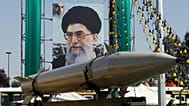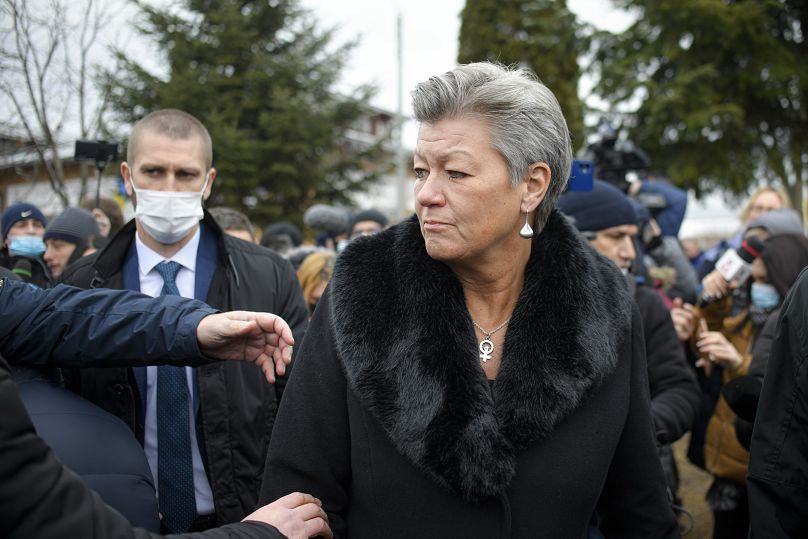The 2001 EU directive will allow member states to grant temporary protection to those fleeing the war in Ukraine.
The European Commission says it is ready to activate a never-used mechanism that could pave the way for millions of Ukrainians fleeing Russia's invasion to find shelter across the European Union.
According to the United Nations, more than 500,000 refugees have fled from Ukraine into neighbouring countries, with more than half entering Poland.
Hungary, Moldova, Romania, Slovakia and even Belarus have also registered new arrivals.
The Commission warns the military attack could result in one of Europe's largest humanitarian crises, with seven million Ukrainian expected to be displaced and 18 million to be affected by the conflict, from of a total population of 41 million citizens.
"It makes me want to cry all the time because I see what's happened in other regions. You know, our [region] is quiet, but there is people dying, and children dying. And they [Russia] have the audacity to say that it was us," Svitlana Ivanova, a Ukrainian refugee who fled to Romania, told Euronews.
In contrast to previous migration waves, member states have shown a rapid and unified political will to host the war refugees, even if the massive and abrupt influx poses a logistic challenge for governments.
Poland has opened its borders to all Ukrainians and dropped its requirement to show a negative COVID-19 test. Germany and Austria are offering free-of-charge train journeys for those seeking to reach their countries.
Meanwhile, Ylva Johansson, the European Commissioner for home affairs, says the executive is ready to trigger an old, obscure EU directive that could provide the bloc with a fast way to manage the influx of refugees.
"This is really a situation where we could have millions of people on our territory and then we need to make sure that they have the proper protection and that they have the proper rights," Johansson told Euronews during a visit to Romania, where she was visiting a camp for Ukrainian refugees.
"Most of Ukrainians coming now, they are coming with passports that give them visa free entry for 90 days. But we have to prepare for day 91."
Johansson hopes the Temporary Protection Directive could help EU countries manage and share the applications of all the Ukrainian nationals who are expected to enter the bloc in the coming weeks.
The instrument could be adopted for the first time as early as Thursday, she noted.
"I think there will be a broad support for [the activation]. We had a first discussion. Of course, everything goes very quick now, and some member states might need some more time, but I hope that we will be able to adopt it already on Thursday," the Commissioner said.
What is the Temporary Protection Directive?
Approved in 2001 after the wars in Yugoslavia and Kosovo, the Temporary Protection Directive is an exceptional scheme that grants immediate and temporary protection to displaced people from non-EU countries who have been forced to leave their homes due to an armed conflict, endemic violence or systematic violations of their human rights.
The mechanism is intended to work when the traditional asylum system is overwhelmed by a mass and unexpected arrival of migrants. It is designed to strike a "balance of efforts" between member states: the allocation of refugees is done according to the accommodation capacities of each country.
"This temporary protection mechanism really works if you have a lot of people already on your territory," said Johansson.
The text does not precise what constitutes a "mass influx" and simply describes a "large number of displaced persons" who are unable to return safely to their home countries.
How does the process work?
The first step must come from the European Commission.
After assessing the situation on the ground, the executive can put forward a proposal to member states. The analysis has to explain the profiles who will be allowed to apply for the temporary protection, an estimate of the size of the influx and the starting date of the mechanism.
Taking into account the Commission's proposal, the EU Council -- which consists of national ministers -- can vote to activate the temporary protection by a qualified majority (at least 15 member states that represent at least 65% of the EU population).
Due to their op-out clauses, Ireland and Denmark are not bound by the legislation.
The temporary protection is granted for one year and can be automatically extended twice for six months. The Council can decide to further extend the protection by another year if the circumstances that triggered the displacement are still present -- in this case, if the war in Ukraine is still ranging on.
In total, the protection can last up to three years.
What are the obligations for EU countries?
After the Council votes in favour of activating the mechanism, all EU states – except Ireland and Denmark – are compelled to receive displaced people and adhere to a series of obligations.
The main obligation is to issue residence permits for those who have been granted temporary protection so they can legally reside in the country for the duration of their stay.
The law asks countries to reduce formalities "to a minimum" due to the urgency of the situation.
Additionally, EU countries are asked to help protected people to obtain work permits, training, suitable accommodation, access to social welfare, medical treatment and professional assistance. Children must be allowed to access the education system in the same conditions as the residents of the member state.
The directive also lays down criteria for the reunification of separated families in the case that one or several relatives enjoy temporary protection but others do not. Once reunited, all members have to be granted residence permits to stay in the host country.
Does temporary protection equal asylum?
No. Being granted temporary protection under the EU directive does not automatically mean the person is granted asylum.
But those who have received temporary protection are able to lodge an asylum application at any time during their stay. If the application is rejected, the individual can continue to enjoy the special protection until the expiration date.
What happens after the temporary protection ends?
When the temporary protection ends and asylum has not been granted, the host country is legally entitled to ask the displaced person to voluntarily return to their country of origin.
If the person refuses, the government can execute a so-called forced expulsion, although the directive urges countries to consider "humanitarian reasons" that might make the return impossible.
Children enrolled in the education system and people with health conditions can be allowed to stay in the country after the temporary protection expires.
















